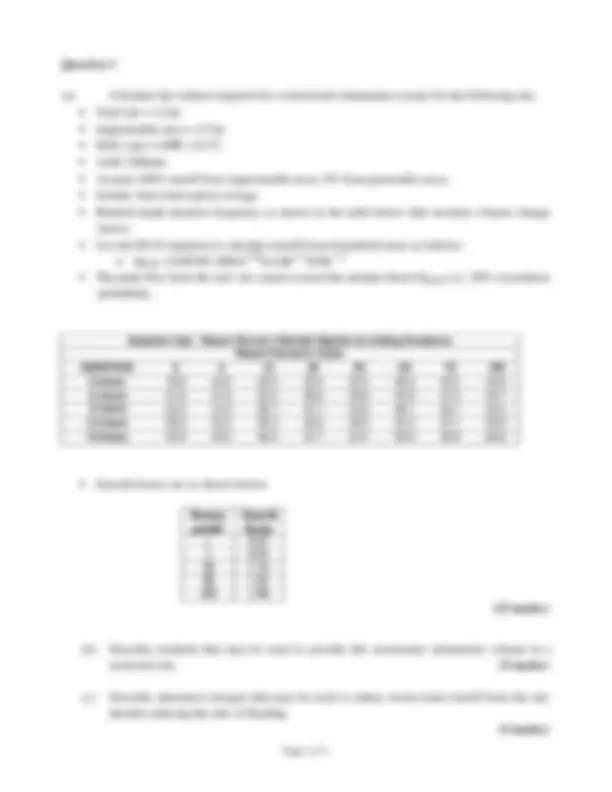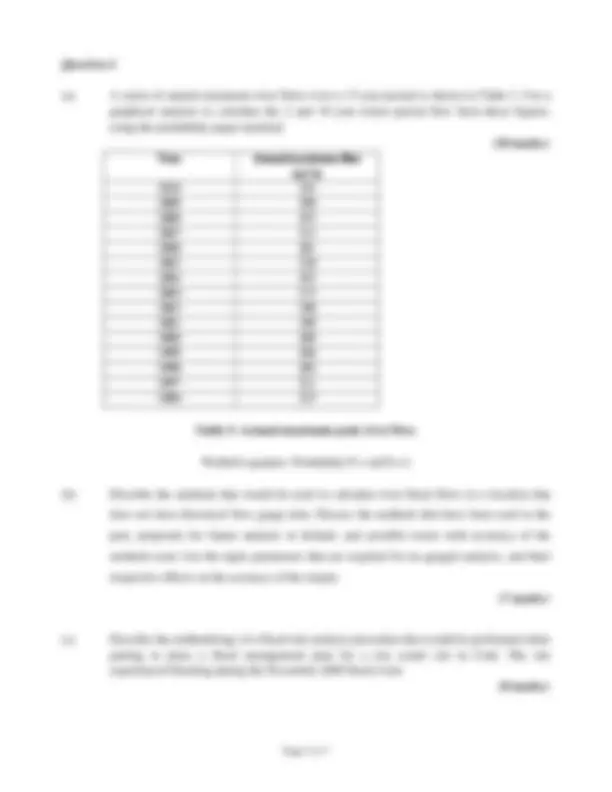





Study with the several resources on Docsity

Earn points by helping other students or get them with a premium plan


Prepare for your exams
Study with the several resources on Docsity

Earn points to download
Earn points by helping other students or get them with a premium plan
Community
Ask the community for help and clear up your study doubts
Discover the best universities in your country according to Docsity users
Free resources
Download our free guides on studying techniques, anxiety management strategies, and thesis advice from Docsity tutors
Main points of this past exam are: Average Overflow Rate, Population Equivalent, Population Equivalent, Aeration Tanks, Design Parameters, Kinetic Yield Coefficient, Secondary Treatment System, Allowable Bod Concentration
Typology: Exams
1 / 7

This page cannot be seen from the preview
Don't miss anything!




Semester 2 Examinations 2011/
Module Code: CIVL
School: Building and Civil Engineering
Programme Title: Bachelor of Engineering (Honours) in Structural Engineering Certificate in Environmental & Energy Engineering
Programme Code: CSTRU_8_Y EENEN_8_Y
External Examiner(s): Dr M. Richardson, Mr J. O’Mahony Internal Examiner(s): Mr T.L. O’Driscoll
Instructions: Answer any four questions.
Duration: 2 hours
Sitting: Summer 2012
Requirements for this examination:
Note to Candidates: Please check the Programme Title and the Module Title to ensure that you have received the correct examination paper. If in doubt please contact an Invigilator.
A treatment plant is proposed for a town with a population equivalent (PE) of 35,000. Assume that 1PE equates to 60g BOD/day and 220L/PE/day. Wastewater is to be treated to the 25/35 standard. Suspended solids concentration at the inlet to the works is 250 mg SS/L. The treatment plant is to be designed to include primary settlement, followed by an activated sludge system.
(a) Calculate the plan area and depth of the primary sedimentation tanks and the primary sludge production rate (tonnes dry solids/day), given the following design parameters: Average overflow rate = 1.5 m^3 /m^2 /hr Average hydraulic retention time, 2.5 hours BOD removal rate = 30% Suspended solids removal rate 50% Waste primary sludge concentration 1.5% solids (5 marks)
(b) Calculate the volume of the aeration tanks, given the following design parameters: Kinetic yield coefficient, Y = 0.6kg cells/kg BOD 5 Endogenous decay coefficient, kd = 0.05 day- MLSS (X) = 3500mg/L Mean cell residence time = 10 days Settled sludge concentration = 8000mg/L
X = c.Y(So-S) / (1+kdc) (6 marks)
(c) Calculate the F/M ratio for the secondary treatment system. (4 marks)
(d) The maximum allowable BOD concentration in the river downstream of the outfall is 3 mg/L. The flow in the river exceeds 3.1 m^3 /s for 95% of the time. Does the river have an adequate capacity to assimilate treated wastewater from the plant, if the background BOD concentration in the river is 1.2 mg/L? WAC = (Cmax – Cback) x F 95 x 86.4 kg BOD/day (5 marks) (e) Calculate the actual BOD concentration in the river downstream for the minimum summertime river flow of 2.2 m^3 /s during peak morning flow, using a peak flow factor of 3DWF. Does this exceed the allowable BOD concentration? (5 marks)
(a) Calculate the volume required for a stormwater attenuation system for the following site. Total site = 12 ha Impermeable area = 2.5 ha SOIL type 3 (SPR = 0.37) AAR 1200mm Assume 100% runoff from impermeable areas, 0% from permeable areas. Include 5mm interception storage. Rainfall depth duration frequency as shown in the table below (this includes climate change factor). Use the IH124 equation to calculate runoff from Greenfield areas as follows: o QBAR = 0.00108 AREA0.89SAAR1.17SOIL2. The peak flow from the new site cannot exceed the median flood (QMED) i.e. 50% exceedence probability.
Question 3(a): Return Period v Rainfall Depths for sliding Durations Return Period in Years DURATION 2 5 10 20 30 50 75 100 4 hours 18.6 24.2 28.2 32.5 35.3 39.0 42.2 44. 6 hours 21.6 27.8 32.2 36.9 39.8 43.8 47.2 49. 9 hours (^) 25.2 31.9 36.7 41.7 44.9 49.1 52.7 55. 12 hours 28.0 35.3 40.3 45.6 48.9 53.3 57.1 59. 9 18 hours 32.6 40.5 46.0 51.7 55.2 59.9 63.9 66.
Growth factors are as shown below:
Return period
Growth factor 1 0. 2 0. 20 1. 30 1. 100 1. (15 marks)
(b) Describe methods that may be used to provide this stormwater attenuation volume in a restricted site. (5 marks)
(c) Describe alternative designs that may be used to reduce storm-water runoff from the site, thereby reducing the risk of flooding. (5 marks)
(a) A series of annual maximum river flows over a 15 year period is shown in Table 3. Use a graphical analysis to calculate the 2 and 10 year return period flow from these figures, using the probability paper attached. (10 marks) Year Annual maximum flow (m^3 /s) 2010 235 2009 198 2008 192 2007 215 2006 201 2005 228 2004 195 2003 175 2002 230 2001 239 2000 189 1999 196 1998 204 1997 211 1996 227
Table 3: Annual maximum peak river flow.
Weibull equation: Probability P = m/(N+1)
(b) Describe the methods that would be used to calculate river flood flows in a location that
does not have historical flow gauge data. Discuss the methods that have been used in the past, proposals for future analysis in Ireland, and possible issues with accuracy of the methods used. List the input parameters that are required for un-gauged analysis, and their respective effects on the accuracy of the output. (7 marks)
(c) Describe the methodology of a flood risk analysis procedure that would be performed when putting in place a flood management plan for a city centre site in Cork. The site experienced flooding during the November 2009 flood event. (8 marks)